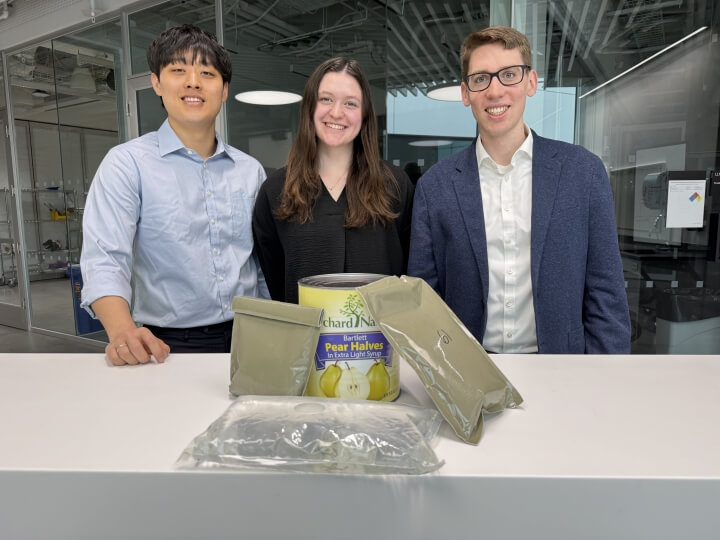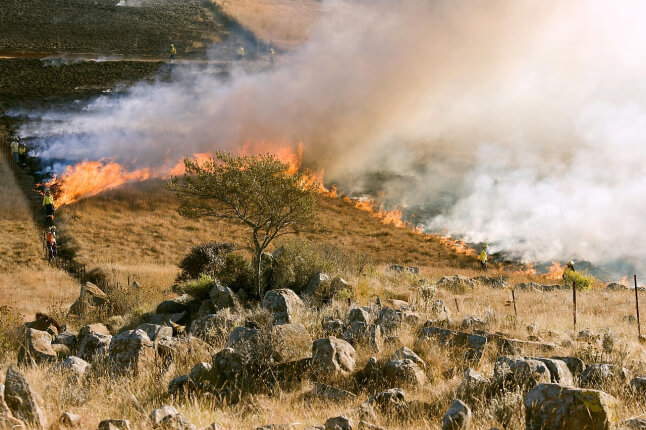News
For their senior capstone project, Ray Noh, Faith Schmidt and Josh Halberstadt designed a lightweight group rations pouch for soldiers (Matt Goisman/SEAS)
Engineering Design Projects (ES 100), the capstone course at the Harvard John A. Paulson School of Engineering and Applied Sciences (SEAS), challenges seniors to engineer a creative solution to a real-world problem.
It's Chow O'Clock: Group Serving Pouch for the Combat Feeding Directorate
Josh Halberstadt, Ray Noh, S.B. ‘25, Mechanical Engineering, Faith Schmidt, S.B. ‘25, Environmental Science and Engineering
Advisor: Danielle Froio-Blumsack and Jacqueline Leblanc
• Please give a brief summary of your project.
The Unitized Group Ration (UGR) is the U.S. military’s group ration for operational units. Designed to feed 50 soldiers, these UGRs are filled with enough food to supply active soldiers with tasty and nutritious meals, and must be packaged to endure any environment. Fluid-containing foods, such as canned vegetables and fruits, are packaged in #10 metal cans within the UGR. The #10 metal cans used in the UGR are heavy, difficult to open, and burdensome to dispose of in a deployed environment. This project successfully developed a group serving pouch (GSP) that can replace #10 cans in the military's group rations. This project addresses a technical challenge in trying to make these GSPs strong enough to survive rigorous transportation processes and a wide array of environments. Societally, this project addresses usability issues military members are challenged with in the field, as well as addresses the sustainability implications of the #10 Can and GSP within the UGR.
• How did you come up with this idea for your final project?
Michelle Lane, SEAS Program Manager for Industry Partnerships, and Mary Kate Bell from the National Security Innovation Network connected us with our technical advisors at the Combat Feeding Directorate in Natick, Mass. Our advisors, Danielle Frioio-Blumsack and Jaqueline Leblanc, presented the problem to us and helped us design and build our solution.
• What was the timeline of your project?
We started defining and outlining our project in April of 2024. From there, we finalized our project scope in August, then began designing and building until December. We began our testing and iterating in January and concluded our project and findings in March.
• What part of the project proved the most challenging?
Our first few designs failed, and we had no idea why they were failing. It challenged us to come up with different ideas of analyzing the failures of the pouches, such as imaging the failure points with an SEM or mapping the failures and determining the correlation between pouch designs and where they fail.
• What part of the project did you enjoy the most?
While it was unfortunate our first test failed and it was really challenging, it was fun to problem solve and iterate until we finally got a successful pouch!
• What did you learn, or skills did you gain, through this project?
We learned how to manage a project from start to finish, and how to work under a time constraint to deliver a working product.
Topics: Academics, Environmental Science & Engineering, Materials Science & Mechanical Engineering
Cutting-edge science delivered direct to your inbox.
Join the Harvard SEAS mailing list.
Press Contact
Matt Goisman | mgoisman@g.harvard.edu



